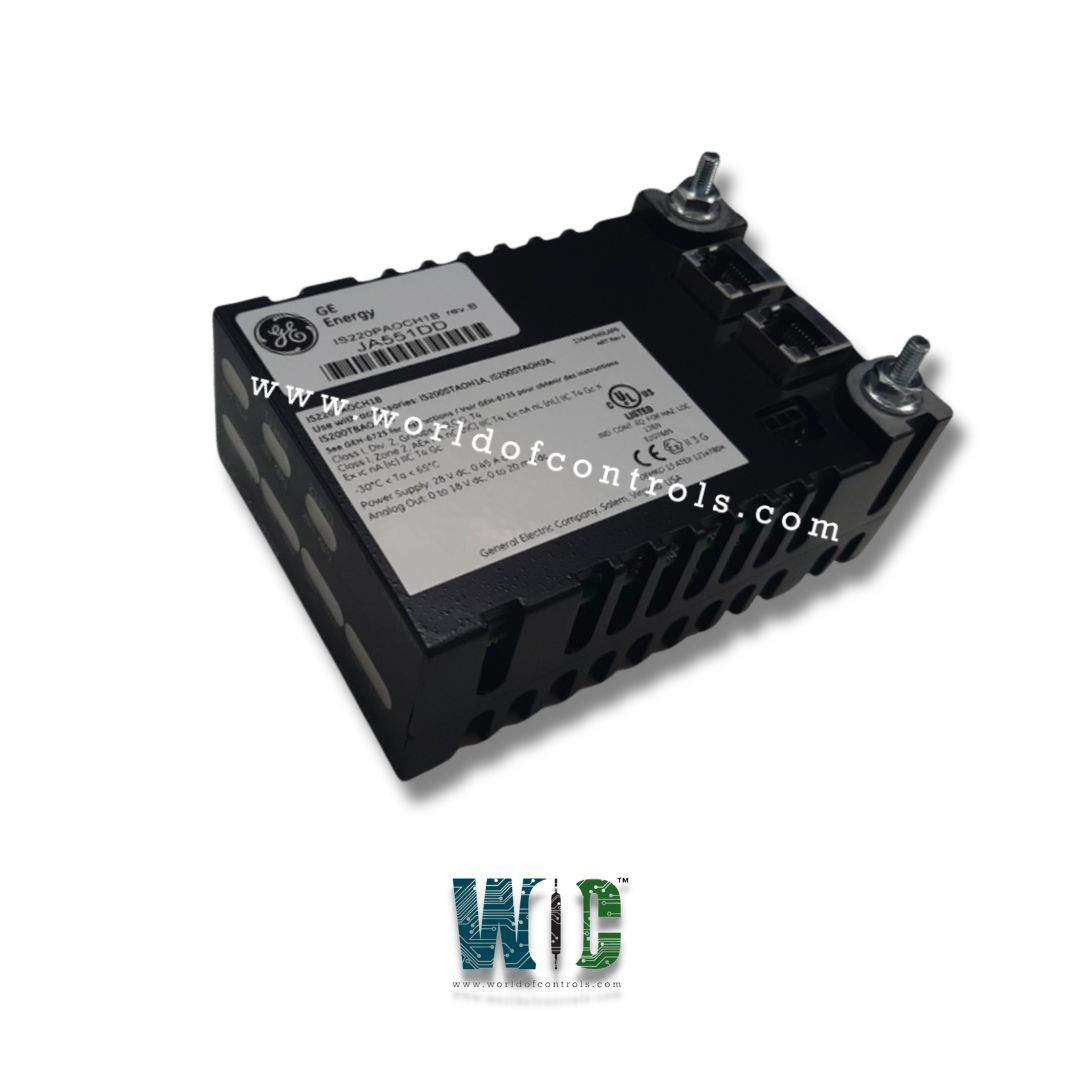SPECIFICATIONS
Part No.: IS220PAOCH1BE
Manufacturer: General Electric
Country of Manufacture: United States of America (USA)
Frame rate: 100 Hz on all eight outputs
Size: 8.26 cm high x 4.19 cm wide x 12.1 cm deep
Temperature: -30 to +65 oC
Technology: Surface mount
Product Type: Analog Output Module
Availability: In Stock
Series: Mark VIe
Functional Description
IS220PAOCH1BE is an analog output module developed by GE. It is a part of the Mark VIe control system. It is the vital electrical intermediary linking one or two I/O Ethernet networks with an analog output terminal board within the Mark VIeTM system. Comprising a processor board that is common to all Mark VIeTM distributed I/O packs and a pair of acquisition boards tailored specifically for the analog output function, the PAOC is engineered to facilitate seamless communication and control.
Features
- Eight simplex 0-20 mA current loop outputs. It achieves this by integrating an analog-to-digital converter dedicated to each output, ensuring precise monitoring and feedback of current levels from each channel.
- For input, it employs dual RJ45 Ethernet connectors, ensuring a robust and reliable connection to the I/O Ethernet networks. Power is supplied through a three-pin input, contributing to the pack's efficiency and streamlined functionality. On the output side, it utilizes a DC-37 pin connector, establishing a direct and secure connection with the associated terminal board connector.
- In terms of diagnostics, the PAOC incorporates indicator LEDs for visual feedback, offering a quick and convenient means of assessing the operational status. Additionally, local diagnostic serial communications can be facilitated through an infrared port, providing an alternative and efficient method for diagnostic purposes.
- The design of the PAOC underscores its importance in the Mark VIeTM system, enabling precise analog output control while ensuring reliable and efficient communication with the broader I/O network.
Installation Procedure
- Prepare Terminal Board: Securely mount the desired terminal board onto the designated location.
- Connect PAOC I/O Pack(s): Directly plug one PAOC I/O pack into the terminal board connectors for simplex operation. For TMR (Triple Modular Redundancy) operation, use three PAOC I/O packs. Ensure a snug fit and proper alignment.
- Secure Mechanically: Use the threaded studs located adjacent to the Ethernet ports to mechanically secure the PAOC packs. These studs should slide into a mounting bracket specific to the terminal board type. Adjust the bracket location to prevent any right-angle force applied to the DC37 connector between the pack and the terminal board. Note: This adjustment is typically a one-time requirement during the product's lifespan.
- Connect Ethernet Cables: Plug in one or two Ethernet cables based on the system configuration. The PAOC pack operates over either port. If dual connections are used, connect ENET1 to the network associated with the R controller.
- Apply Power: Supply power to the pack by plugging in the connector on the side of the pack. Note: It is not necessary to insert this connector with the power removed from the cable, as the I/O pack features inherent soft-start capability, controlling current inrush upon power application.
- Configure I/O Pack: Once powered, configure the I/O pack as required for your specific application.
- Additional Notes: The PAOC mounts directly to a Mark VIe terminal board. Simplex terminal boards have a single DC-37 pin connector that receives the PAOC. TMR-capable terminal boards have six DC-37 pin connectors, of which only two may be used by PAOC packs. One is for the first eight outputs, and the other is for the second eight outputs. It is designed for simplex operation only.
Processor
- Ethernet Input Logic: The processor application code encompasses all the essential logic required for the I/O pack to function seamlessly with either one or two Ethernet inputs. This logic enables the I/O pack to adapt dynamically based on the number of active Ethernet connections.
- Dual Ethernet Operation: In cases where the I/O pack operates with two Ethernet inputs, both network paths remain active continuously. This design choice ensures that a failure in either network path does not disrupt the operation of the I/O pack. Any network failure is efficiently managed, and the operational status is indicated through the functioning network connection.
- Fault Tolerance Mechanism: The dual Ethernet operation provides a high level of fault tolerance. Unlike classic hot-backup systems, where the secondary port is activated only after detecting a primary port failure, the I/O pack maintains continuous functionality irrespective of the operational status of either network path. This proactive approach minimizes disturbances and enhances the overall reliability of the system.
- Network Failure Indication: Any failure in the Ethernet network is promptly indicated through the working network connection. This real-time feedback mechanism ensures that system operators are promptly alerted to any issues, facilitating quick diagnosis and resolution.
- Auto-Negotiation Capabilities: The Ethernet ports on the processor feature auto-negotiation capabilities, allowing them to dynamically adjust their speed between 10 MB/s and 100 MB/s. Additionally, the ports can auto-negotiate between half-duplex and full-duplex operation. This adaptability ensures optimal performance based on the network conditions, contributing to the efficiency and versatility of the I/O pack.
The WOC team is always available to help you with your Mark VIe requirements. For more information, please contact WOC.
Frequently Asked Questions
What is IS220PAOCH1BE?
It is an analog output module developed by GE under the Mark VIe series.
Why is de-rating necessary for the pack's ambient environment?
De-rating is essential due to the dense triple-board configuration, ensuring optimal performance across various applications and environmental conditions.
In what scenarios is de-rating required for the PAOC?
De-rating is contingent upon the specific application. The dense triple-board configuration may necessitate adjustments based on the desired output configurations.
How is the de-rating determined for each output configuration?
The de-rating is determined based on the ambient environment and the dense triple board configuration. It ensures that the PAOC pack operates within specified limits for optimal performance.
